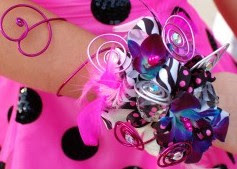Bulbs are one of nature's little care packages filled with wonder and surprise. A gardener can plop some bulbs in the ground and in just a few months, up pops a colorful masterpiece. Then what? Here's a few tips on care of bulbs so that they can reward you with years of eye candy (assuming the kids and the wildlife don't ruin them first):
 |
Bulb planting charts
(bhg.com) |
When planting bulbs, follow depth instructions on the package. It's always better to turn over a mound of soil when planting, then add soil amendments if necessary, rather then just digging up a little dish full with your hand shovel that's just barely big enough for the bulb to squeeze into. Give those tender little roots a chance rather than making them struggle to grow in hard, dry, never-before-touched-by-humankind-soil.
 |
Various bulb sizes
(alinthegarden.co.uk) |
Though not really necessary, you can give newly planted bulbs a sprinkle of bulb food or bone meal by placing it in the planting hole prior to placing the bulb. If it makes you feel better, go for it. But when the bulbs arrive at your home for planting, they generally have been well fed and are ready without needing a "bedtime" snack. Water well after planting and before the ground freezes.
 |
Masses of bulbs planted in color blocks
(flowerbulbsgarden.com) |
For a more spectacular show, don't plant bulbs in a row like little tin soldiers. Plant them in clusters of 15 or 25 for smaller bulbs, and groups of 5-10 for larger bulbs. We're going for drama here!
 |
Young green spring bulb sprouts
(b.love2bnmaine.com) |
If you live in a dry climate that doesn't get a boost of spring rain, you'll have to provide the watering services. This is especially true when little green sprouts appear indicating that the bulb is awake. A good soak a few times a week should suffice.
 |
Spring bulb bouquet with daffodils
(oldhousegardens.com) |
After the flowers appear, and you start to dream of making a bouquet, keep a few things in mind before you go clipper-happy. While cutting some greenery from the bulb plant to accompany the flower stem is fine, don't cut too much or all of it. That greenery will play an important role before the plant goes dormant.
 |
Tulip bulb seed pods
(greenwalks.wordpress.com) |
After the flower fades, don't allow the seed pod to form, by cutting off the dead flower stem. Growing and nurturing the seed pod will take away valuable nutrients from next year's flowers.
As the flower begins to fade and the lone greenery is left, please resist the temptation to chop it all down like a crew-cut so that you can plant your summer annuals. Here is why: as the bulb moves into dormancy, the greenery slowly dies. But as it dies, critical nutrients are being pulled down into the bulb to provide it the 'umph' to grow again next spring. If there is no greenery, there are no nutrients. This move into dormancy is a good time to give your bulbs another shot of bulb food (which is what the grower did before sending it to you or the store). Bulbs need yearly feeding to stay productive and happy. General rule of thumb: when you can pull off the foliage without any resistance, it's safe to remove it.
 |
Mother bulbs with baby bulblets
(landspro.com) |
With each passing year, when taken care of properly, bulbs will grow little baby bulbs. They start out small, about the size of a pea, then continue to grow and mature. This is why a dozen daffodils planted in one year can produce a hundred daffodils in the years to come. Some bulbs are better at reproducing than other bulbs. Growing conditions can also make a difference--too much summer water can mildew and rot dormant bulbs in the ground.
 |
Thanksgiving Point Gardens, Lehi, Utah
(makeitworkmom.com) |
For maximum bloom performance, grounds of commercial gardens and buildings generally plant new bulbs each year, and often will sell the used bulbs to the public at a significant price savings. It doesn't mean the bulb won't perform the next year, it just means the commercial establishment can't take a chance on a lackluster performance in their garden beds the following year and they can afford to do a complete overhaul. But the home gardener often doesn't mind taking the risk or waiting out the dying foliage...just don't forget to feed them as mentioned earlier.
As the foliage dies, an occasional watering is a good idea. This enables the bulb food that you've placed on the ground and worked into the top inch or so of soil, to be fully dissolved and absorbed into the soil.
 |
Gladiolus
(edenbrothers.com) |
Keep in mind that bulbs don't just bloom in the spring, such as tulips, daffodils, crocus, and iris. Research all the varieties of summer blooming bulbs as well, such as asiatic lilies, gladiolus, allium, dahlias (which are technically tubers), and many others. The same care instructions apply to all bulbs.
Just one more thing, please, oh please, do not plant the bulbs upside down...the poor things already have to work so hard to grow. Remember, it's pointed end up!





















































